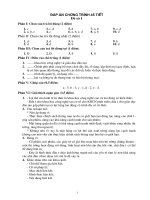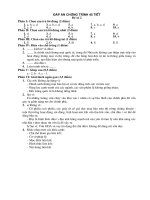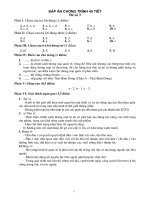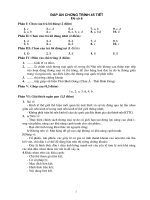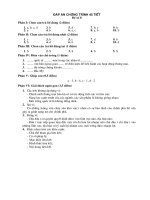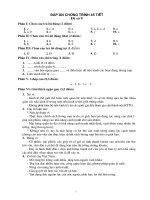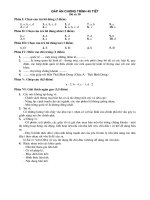KIỂM TRA TỔNG HỢP CHUYÊN ĐỀ: UNIT 10: SOURCES OF ENERGY MÔN TIẾNG ANH LỚP 7 có đáp án
Bạn đang xem bản rút gọn của tài liệu. Xem và tải ngay bản đầy đủ của tài liệu tại đây (0 B, 19 trang )
ĐỀ THI GIỮA HỌC KÌ 2 – ĐỀ SỐ 1
MƠN: TIẾNG ANH 7
THỜI GIAN LÀM BÀI: 45 PHÚT
BAN CHUYÊN MÔN - TUYENSINH247.COM
e8311 I. Choose the word whose underlined part is pronounced differently from the others.
(Chọn từ có cách phát âm khác với những từ cịn lại sau đó khoanh vào đáp án A, B, C hay D)
1. A. arrived
B. watched
C. packed
D. typed
2. A. attended
B.washed
C. decided
D. disappointed
3. A. hand
B. transport
C. character
D. celebration
e8312 II. Choose the word that has a different stress pattern from the others. ( Chọn từ có dấu trọng
âm khác với những từ cịn lại sau đó khoanh vào đáp án A, B, C hay D)
4. A. children
B. singer
C. forget
D. parents
5. A. enjoy
B. agree
C. attend
D. student
e8313 III. Choose the correct answer to complete each following sentence by circling A, B, C or D.
(Chọn và khoanh vào đáp án đúng nhất để hoàn thành câu)
6. Linda used to __________________ morning exercise when she got up early.
A. did
B. does
C. doing
D. do
7. Keep silent! The teacher _______________.
A. is coming
B. coming
C. are coming
D. come
8. You should look right and left when you go ________________the road.
A. down
B. across
C. up
D. along
9. Bus is the main public ________________in Viet Nam.
A.travel
B. tricycle
C. transport
D. vehicle
10. The film was so boring . ______________, An saw it from beginning to end.
A. Therefore
B. Despite
C. However
D. Although
11. Lan: How__________________ are you? - Nam: I am 1.5 meter in height.
A. high
B. tall
C. height
D. long
12. Ba: I like chicken and beef. - Mai: ________________ .
A. So do I
B. So don't I
C. Netheir do I
D. I don't, either
13. __________________ being frightened by the images, Lan still liked the film so much.
A. In spite
B. Despite
C. Although
D. Nevertheless
14. ________________ is La Tomatina celebrated? – Every August.
A. Where
B. Why
C. When
D. Which
15. My father liked the _________________ of that singer.
A. perform
B. performer
C. performance
D. performing
e8314 IV. Có một lỗi sai ở một trong bốn phần gạch chân của mỗi câu dưới đây. Tìm và khoanh và
khoanh vào lỗi sai đó ( A, B, C, hoặc D).
16. Mary is a singer beautiful. She sings very beautifully.
A. a
B. singer beautiful
C. sings
D. beautifully
17. I don't like soccer and neither do my sister.
A. like
B. neither
C. do
D. sister
18. Would you like going to the restaurant with me tonight?
A. you
B. going
C. the
D. with
19. Vinh Phuc is famous to Tam Đao mountain and Dai Lai lake.
A. to
B. mountain
C. and
D. Lake
1 Truy cập trang để học Toán – Lý – Hóa – Sinh – Văn – Anh – Sử
- Địa – GDCD tốt nhất!
20. My mother likes "Co Dau 8 Tuoi film" because the film is so interested.
A. My mother likes
B. because
C. the film
D. interested
e8315 V. Put the correct form of the verb in brackets: (Chia động từ cho trong ngoặc ở dạng thích
hợp)
21. An didn’t use (play) ……………..……. football in the afternoon. Now he often does it.
22. Nam (learn) ………………………..............…….. English for 8 years.
23. Last night, my father (watch) ……..........…………………..TV.
24. Ba and I (visit)…………....................……….. Ha Long Bay this summer vacation.
25. I like (work) …………..........…..........………….. as a volunteer for that orphanage.
e8316 VI . Read the passage then decide whether each sentence is True(T) or False (F): ( Đọc đoạn văn
sau đó chọn câu đúng (T) / sai (T).
Marie was born in Poland in 1867. She learnt to read when she was 4 years old. She was intelligent and
had an excellent memory. She finished high school when she was only 15 years old. When she grew up,
Marie went to Paris to study Mathematics and Chemistry at the University. She won the Nobel Prize for
Physics in 1903 and 8 years later she received the Nobel Prize for Chemistry. Marie Curie died in 1934.
26. Marie was born in England in 1867.
................
27. She could read when she was 4 years old.
………….
28. She finished high school when she was 16.
………….
29. She received the Nobel Prize for Mathematics and Chemistry.
………….
30. She died when she was 67 years old.
………….
e8317 VII. Read the following text carefully and choose the correct answer A, B, C or D for each of
the gap. (Đọc kĩ đoạn văn và chọn câu trả lời đúng A,B, C hoặc D để hoàn thành đoạn văn).
When you are in Singapore, you can go around (31) .................. taxi, by bus, or by underground. I myself
prefer the underground (32) ................... it is fast, easy and cheap. There are (33)................. buses and taxis
in Singapore and one cannot drive along the road quickly and without many stops, especially on the Monday
morning. The underground is therefore usually quicker than taxis or buses. If you do not know Singapore
very well, it is difficult (34) ...................... the bus you want. You can take a taxi, but it is (35) .....................
expensive than the underground or a bus. On the underground, you find good maps that tell you the names
of the stations and show you how to get to them, so that it is easy to find your way.
31. A. at
B. in
C. by
D. to
32. A. but
B. because
C. when
D. so
33. A. many
B. a lot
C. any
D. much
34. A. to find
B. find
C. finding
D. found
35. A. less
B. as
C. most
D. more
e8318 VIII. Rewrite these following sentences using given words. ( Viết lại những câu sau sao cho
nghĩa không đổi).
36. What is the distance between Vinh and Ho Chi Minh city?
=> How………………….......................................…………………………………...……….?
37. I walked to school when I was a student.
=> I used to …….........................................………………………………………….…………
38. Although they are short, they still love playing sports.
=> In spite of……….....................................……………………………………………………
39. The distance from Ha Noi to Hai Phong is about 100 km
=> It is about…………………………….........………….........................................................
40. Let’s go swimming.
=> What ..................................................................................................................................?
---THE END--2 Truy cập trang để học Tốn – Lý – Hóa – Sinh – Văn – Anh – Sử
- Địa – GDCD tốt nhất!
HƯỚNG DẪN GIẢI
Thực hiện: Ban chuyên môn – Tuyensinh247.com
1. A
2. B
3. D
4. C
5. D
6. D
7. A
8. B
11. B
12. A
13. B
14. C
15. C
16. B
17. C
18. B
21. to play
22. has learnt
23. watched
24. are going to visit
25. working
26. F
27. T
28. F
30. T
31. C
32. B
34. A
35. D
36. How far is it from Vinh to Ho Chi Minh City?
37. I used to walk to school when I was a student.
38. In spite of being short, they still love playing sports.
39. It is about 100 km from Ha Noi to Hai Phong.
40. What about going swimming?
9. C
19. A
10. C
20. D
29. F
33. A
3 Truy cập trang để học Tốn – Lý – Hóa – Sinh – Văn – Anh – Sử
- Địa – GDCD tốt nhất!
HƯỚNG DẪN GIẢI CHI TIẾT
1. A
Kiến thức: Phát âm đuôi “ed”
Giải thích:
A. arrived /əˈraɪvd/
B. watched /wɒtʃt/
C. packed /pỉkt/
D. typed /taɪpt/
Cách phát âm đuôi “ed”:
+ Đuôi “ed” được phát âm là /t/ khi động từ có phát âm kết thúc là /tʃ/, /θ/, /ʃ/, /s/, /k/, /p/, /f/
+ Đuôi “ed” được phát âm là /ɪd/ khi động từ có phát âm kết thúc là /t/, /d/
+ Đuôi “ed” được phát âm là /d/ với các trường hợp còn lại
Phương án A đi “ed” được phát âm là /d/, cịn lại phát âm là /t/
Chọn A.
2. B
Kiến thức: Phát âm đuôi “ed”
Giải thích:
A. attended /əˈtendɪd/
B. washed /ˌwɒʃt/
C. decided /dɪˈsaɪdɪd/
D. disappointed /ˌdɪsəˈpɔɪntɪd/
Phương án B đi “ed” được phát âm là /t/, cịn lại phát âm là /ɪd/
Chọn B.
3. D
Kiến thức: Phát âm “-a”
Giải thích:
A. hand /hỉnd/
B. transport /ˈtrỉnspɔːt/
C. character /ˈkỉrəktə(r)/
D. celebration /ˌselɪˈbreɪʃn/
Phương án D phần gạch chân phát âm là /eɪ/, còn lại phát âm là /ỉ/
Chọn D.
4. C
Kiến thức: Trọng âm
Giải thích:
A. children /tʃɪldrən/
B. singer /ˈsɪŋə(r)/
C. forget /fəˈɡet/
D. parents /ˈpeərənt/
Phương án C trọng âm rơi vào âm thứ 2, còn lại âm thứ 1
Chọn C.
5. D
Kiến thức: a
Giải thích:
A. enjoy /ɪnˈdʒɔɪ/
B. agree /əˈɡriː/
C. attend /əˈtend/
D. student /ˈstjuːdnt/
4 Truy cập trang để học Tốn – Lý – Hóa – Sinh – Văn – Anh – Sử
- Địa – GDCD tốt nhất!
Phương án D trọng âm rơi vào âm thứ 1, còn lại âm thứ 2
Chọn D.
6. D
Kiến thức: Cấu trúc “used to”
Giải thích: used to + V_nguyên thể: đã từng làm gì trong q khứ và bây giờ khơng làm nữa
Tạm dịch: Linda đã từng tập thể dục buổi sáng khi cơ ấy dậy sớm.
Chọn D.
7. A
Kiến thức: Thì hiện tại tiếp diễn
Giải thích: Dấu hiệu: động từ chỉ sự chú ý “Keep silent” –“Hãy giữ im lặng”
Cách dùng: Diễn tả hành động đang xảy ra tại thời điểm nói
Cấu trúc: S + am/ is/ are +V_ing.
Tạm dịch: Hãy giữ im lặng! Giáo viên đang vào.
Chọn A.
8. B
Kiến thức: Cụm động từ
Giải thích:
A. go down: đi xuống
B. go across: đi qua, băng qua
C. go up: di lên
D. go along: đi dọc theo
Tạm dịch: Bạn nên nhìn phải và trái khi bạn đi qua đường.
Chọn B.
9. C
Kiến thức: Từ vựng
Giải thích:
A. travel (n): sự di chuyển
B. tricycle (n): xe ba bánh
C. transport (n): phương tiện đi lại
D. vehicle (n): xe cộ
public transport: phương tiện giao thông công cộng
Tạm dịch: Xe buýt là phương tiện giao thơng cơng cộng chính ở Việt Nam.
Chọn C.
10. C
Kiến thức: Liên từ
Giải thích:
A. Therefore: do đó
B. Despite: mặc dù
C. However: tuy nhiên
D. Although: mặc dù
Tạm dịch: Bộ phim rất nhàm chán. Tuy nhiên, An đã xem từ đầu đến cuối.
Chọn C.
11. B
Kiến thức: Từ để hỏi
Giải thích: How + tall + tobe + S?: ai đó cao như thế nào?
A. high (adj): cao, dùng để miêu tả chiều cao của đồ vật
B. tall (adj): cao, dùng để miêu tả chiều cao của con người
C. height (n): chiều cao
5 Truy cập trang để học Toán – Lý – Hóa – Sinh – Văn – Anh – Sử
- Địa – GDCD tốt nhất!
D. long (adj): dài
Tạm dịch: Lan: Bạn cao bao nhiêu? – Nam: Tôi cao 1,5 mét.
Chọn B.
12. A
Kiến thức: Đồng tình câu khẳng định
Giải thích:
So + trợ động từ + S: đồng tình câu khẳng định
Neither + trợ đồng tử + S: đồng tình câu phủ định
S + trợ động từ + not, either: đồng tình câu phủ định
A. Tơi cũng vậy
B. Sai cấu trúc
C. Tôi cũng không
D. Tôi cũng khơng
Tạm dịch: Ba: Tơi thích thịt gà và thịt bị. – Mai: Tôi cũng vậy
Chọn A.
13. B
Kiến thức: Liên từ
Giải thích:
In spite of/ Despite + N/ V_ing = Although + S + V: Mặc dù
Nevertheless + S + V: tuy nhiên, tuy thế mà
Sau chỗ trống là V_ing –“being”
Tạm dịch: Mặc dù bị kinh sợ bở hình ảnh, Lan vẫn thích bộ phim rất nhiều.
Chọn B.
14. C
Kiến thức: Từ để hỏi
Giải thích: Câu trả lời về thời gian: “Tháng 8 hàng năm”
A. Where: ở đâu
B. Why: tại sao
C. When: khi nào
D. Which: cái nào
Tạm dịch: La Tomatina được tổ chức khi nào? - Tháng 8 hàng năm.
Chọn C.
15. C
Kiến thức: Từ loại
Giải thích: Trước chỗ trống có mạo từ “the”, sau chỗ trống có “of” => cần điền danh từ hợp nghĩa
A. perform (v): trình diễn
B. performer (n): người biểu diễn
C. performance (n): màn trình diễn
D. performing: việc trình diễn
Tạm dịch: Bố tơi thích màn trình diễn của ca sĩ đó.
Chọn C.
16. B
Kiến thức: Vị trí từ loại
Giải thích: Tính từ đứng tr beautiful ước danh từ để bổ nghĩa cho danh từ
beautiful (adj): xinh đẹp
singer (n): ca sĩ
Sửa: singer beautiful => beautiful singer
Tạm dịch: Mary là một ca sĩ xinh đẹp. Cô ấy hát rất hay.
6 Truy cập trang để học Tốn – Lý – Hóa – Sinh – Văn – Anh – Sử
- Địa – GDCD tốt nhất!
Chọn B.
17. C
Kiến thức: Đồng tình câu phủ định
Giải thích: Neither + trợ động từ + S.
Chủ ngữ là “my sister” => trợ động từ chia thì hiện tại đơn là “does”
Sửa: do => does
Tạm dịch: Tơi khơng thích bóng đá và chị gái tơi cũng khơng thích.
Chọn C.
18. B
Kiến thức: Cấu trúc đưa ra lời mời
Giải thích: Would you like + to V: bạn có muốn … khơng?
Sửa: going => to go
Tạm dịch: Bạn có muốn đi đến nhà hàng với tôi tối nay không?
Chọn B.
19. A
Kiến thức: Cụm từ
Giải thích: tobe famous for: nổi tiếng với cái gì
Sửa: to => for
Tạm dịch: Vĩnh Phúc nổi tiếng với núi Tam Đao và hồ Đại Lải.
Chọn A.
20. D
Kiến thức: Từ loại
Giải thích: adi_ed: dùng để miêu tả cảm xúc
adi-ing: dùng để miêu tả bản chất của sự vật, sự việc
Chủ ngữ là “the film” – bộ phim => cần dùng tính từ miêu tả vật
Sửa: interested => interesting
Tạm dịch: Mẹ tơi thích “Phim Cơ Dâu 8 Tuổi” bởi vì bộ phim rất thú vị.
Chọn D.
21. to play
Kiến thức: Cấu trúc “used to”
Giải thích: used to + V_nguyên thể: đã từng làm gì trong quá khứ
didn’t + use to + V_nguyên thể: đã từng khơng làm gì trong q khứ
Tạm dịch: An đã từng khơng chơi bóng đá vào buổi chiều. Bây giờ anh ấy thường làm điều đó.
Đáp án: to play
22. has learnt
Kiến thức: Thì hiện tại hồn thành
Giải thích: Dấu hiệu: “for 8 years”
Cách dùng: diễn tả hành động đã xảy ra trong quá khứ và còn tiếp diễn đến hiện tại
Cấu trúc: S + have/ has + Vp2
Tạm dịch: Nam đã học tiếng Anh được 8 năm rồi.
Đáp án: has learnt
23. watched
Kiến thức: Thì q khứ đơn
Giải thích: Dấu hiệu “Last night” – “tối qua”
Cách dùng: diễn tả hành động đã xảy ra và kết thúc trong quá khứ
Cấu trúc: S + Ved/ bqt
Tạm dịch: Tối qua, bố tôi đã xem ti vi.
Đáp án: watched
7 Truy cập trang để học Tốn – Lý – Hóa – Sinh – Văn – Anh – Sử
- Địa – GDCD tốt nhất!
24. are going to
Kiến thức: Thì tương lai gần
Giải thích:
Cách dùng: diễn tả hành động sẽ xảy ra trong tương lai gần có dự định trước.
Trong câu có xác định địa điểm “Ha Long Bay “ và thời gian “this summer vacation”
Cấu trúc: S + am/ is/ are + going to + V_nguyên thể
Tạm dịch: Ba và tôi sẽ thăm Vịnh Hạ Long trong kỳ nghỉ hè này.
Đáp án: are going to
25. working
Kiến thức: to V/ V_ing
Giải thích: like + V_ing: thích làm gì
Tạm dịch: Tơi thích làm việc như một tình nguyện viên cho trại trẻ mồ cơi đó.
Đáp án: working
26. F
Kiến thức: Đọc hiểu
Giải thích: Marie được sinh ra ở Anh năm 1867.
Thông tin: Marie was born in Poland in 1867.
Tạm dịch: Marie sinh ra ở Ba Lan năm 1867.
Chọn F.
27. T
Kiến thức: Đọc hiểu
Giải thích: Bà có thể đọc khi bà 4 tuổi.
Thông tin: She learnt to read when she was 4 years old.
Tạm dịch: Bà học đọc khi mới 4 tuổi.
Chọn T.
28. F
Kiến thức: Đọc hiểu
Giải thích: Bà học xong trung học khi bà 16 tuổi.
Thơng tin: She finished high school when she was only 15 years old.
Tạm dịch: Bà học xong trung học khi mới 15 tuổi.
ChọnF.
29. T
Kiến thức: Đọc hiểu
Giải thích: Bà đã nhận giải Nobel Tốn học và Hóa học.
Thơng tin: She won the Nobel Prize for Physics in 1903 and 8 years later she received the Nobel Prize for
Chemistry.
Tạm dịch: Bà đoạt giải Nobel Vật lý năm 1903 và 8 năm sau bà nhận giải Nobel Hóa học.
Chọn T.
30. T
Kiến thức: Đọc hiểu
Giải thích: Bà qua đời khi 67 tuổi.
Thơng tin: Marie was born in Poland in 1867.
Marie Curie died in 1934.
Tạm dịch: Marie sinh ra ở Ba Lan năm 1867.
Marie Curie mất năm 1934.
Chọn T.
Dịch bài đọc:
8 Truy cập trang để học Tốn – Lý – Hóa – Sinh – Văn – Anh – Sử
- Địa – GDCD tốt nhất!
Marie sinh ra ở Ba Lan năm 1867. Bà học đọc khi mới 4 tuổi. Bà ấy thông minh và có trí nhớ tuyệt vời. Bà
học xong trung học khi mới 15 tuổi. Khi lớn lên, Marie đến Paris để học Tốn và Hóa học tại trường Đại
học. Bà đoạt giải Nobel Vật lý năm 1903 và 8 năm sau bà nhận giải Nobel Hóa học. Marie Curie mất năm
1934.
31. C
Kiến thức: Giới từ
Giải thích: by + phương tiện giao thông (taxi, bus, train..)
When you are in Singapore, you can go about (31) by taxi, by bus, or by underground.
Tạm dịch: Khi bạn ở Singapore, bạn có thể đi thăm thú các nơi bằng taxi, xe buýt hoặc tàu điện ngầm.
Chọn C.
32. B
Kiến thức: Liên từ
Giải thích:
A. but: nhưng
B. because: bởi vì
C. when: khi nào
D. so: vậy nên
I myself prefer the underground (32) because it is fast, easy and cheap.
Tạm dịch: Bản thân tơi thích tàu điện ngầm hơn vì nó nhanh chóng, dễ dàng và rẻ.
Chọn B.
33. A
Kiến thức: Từ chỉ lượng
Giải thích:
A. many + danh từ số nhiều đếm được
B. a lot + of + danh từ số nhiều đếm được / danh từ không đếm được
C. any + danh từ số nhiều đếm được / danh từ không đếm được : dùng trong câu phủ định hoặc nghi
vấn
D. much + danh từ không đếm dược
Sau chỗ trống là danh từ đếm được dạng số nhiều “buses”
There are (33) many buses and taxis in Singapore and one cannot drive along the road quickly and without
many stops, especially on the Monday morning.
Tạm dịch: Có nhiều xe buýt và taxi ở Singapore và người ta không thể lái xe dọc đường một cách nhanh
chóng và khơng có nhiều điểm dừng, đặc biệt là vào sáng thứ Hai.
Chọn A.
34. A
Kiến thức: to V/ V_ing
Giải thích: It’s + adj + to V: Nó là như thế nào khi làm gì
If you do not know Singapore very well, it is difficult (34) to find the bus you want.
Tạm dịch: Nếu bạn không hiểu rõ về Singapore, rất khó để tìm được xe bt bạn muốn.
Chọn A.
35. D
Kiến thức: So sánh hơn
Giải thích: Cấu trúc so sánh hơn với tính từ dài: S1 + tobe + more + adj + than + S2
You can take a taxi, but it is (35) more expensive than the underground or a bus.
Tạm dịch: Bạn có thể đi taxi, nhưng nó đắt hơn so với tàu điện ngầm hoặc xe buýt.
Chọn D.
Dịch bài đọc:
9 Truy cập trang để học Tốn – Lý – Hóa – Sinh – Văn – Anh – Sử
- Địa – GDCD tốt nhất!
Khi bạn ở Singapore, bạn có thể đi thăm thú các nơi bằng taxi, xe buýt hoặc tàu điện ngầm. Bản thân tơi
thích tàu điện ngầm hơn vì nó nhanh chóng, dễ dàng và rẻ. Có xe buýt và taxi ở Singapore và người ta
không thể lái xe dọc đường một cách nhanh chóng và khơng có nhiều điểm dừng, đặc biệt là vào sáng thứ
Hai. Do đó, tàu điện ngầm thường nhanh hơn taxi hoặc xe buýt. Nếu bạn khơng hiểu rõ về Singapore, rất
khó để tìm được xe buýt bạn muốn. Bạn có thể đi taxi, nhưng nó đắt hơn so với tàu điện ngầm hoặc xe buýt.
Ở trên tàu điện ngầm, bạn tìm thấy các bản đồ tốt cho bạn biết tên của các ga và chỉ cho bạn cách đi đến
những nơi đó, để bạn dễ dàng tìm đường.
36. How far is it from Vinh to Ho Chi Minh City?
Kiến thức: Từ để hỏi
Giải thích: How far: bao xa => câu hỏi về khoảng cách
Tạm dịch: Khoảng cách giữa Vinh và thành phố Hồ Chí Minh là bao nhiêu?
= Từ Vinh đến Thành phố Hồ Chí Minh bao xa?
Đáp án: How far is it from Vinh to Ho Chi Minh City?
37. I used to walk to school when I was a student.
Kiến thức: Thì quá khứ đơn
Giải thích: used to + V_nguyên thể: đã từng làm gì trong q khứ và bây giờ khơng cịn làm nữa
Tạm dịch: Tôi đã đi bộ đến trường khi tôi cịn là một học sinh.
= Tơi đã từng đi bộ đi học khi tôi là một học sinh.
Đáp án: I used to walk to school when I was a student.
38. In spite of being short, they still love playing sports.
Kiến thức: Mệnh đề nhượng bộ
Giải thích: Although + S + V = In spite of + N/V_ing: Mặc dù
Tạm dịch: Mặc dù họ thấp, họ vẫn thích chơi thể thao.
= Mặc dù thấp, họ vẫn thích chơi thể thao.
Đáp án: In spite of being short, they still love playing sports.
39. It is about 100 km from Ha Noi to Hai Phong.
Kiến thức: Nói về khoảng cách
Giải thích: It’s + số +km from somewhere to somewhere: Bao nhiêu cây số từ…. đến…
Tạm dịch: Khoảng cách từ Hà Nội đến Hải Phòng khoảng 100 km
= Khoảng 100 km từ Hà Nội đến Hải Phòng.
Đáp án: It is about 100 km from Ha Noi to Hai Phong.
40. What about going swimming?
Kiến thức: Câu đưa ra lời gợi ý/ đề nghị
Giải thích: Let’s + V_nguyên thể: Hãy …
= What about + V_ing/ N: Còn việc … thì sao?
Tạm dịch: Hãy đi bơi đi. = Cịn việc đi bơi thì sao?
Đáp án: What about going swimming?
---HẾT---
10 Truy cập trang để học Toán – Lý – Hóa – Sinh – Văn – Anh – Sử
- Địa – GDCD tốt nhất!
THI ONLINE: KIỂM TRA TỔNG HỢP
CHUYÊN ĐỀ: UNIT 10: SOURCES OF ENERGY
MÔN TIẾNG ANH - LỚP 7
BIÊN SOẠN: CÔ GIÁO – NGUYỄN THỊ MAI HƯƠNG –TUYENSINH247.COM
MỤC TIÊU
- Củng cố và mở rộng kiến thức từ vựng về các nguồn năng lượng, ngữ âm về trọng âm của từ và ngữ pháp
chuyên sâu về thì tương lai tiếp diễn và bị động thì tương lai đơn
- Nâng cao kỹ năng làm các dạng bài tập tiếng Anh và biết cách áp dụng kiến thức lý thuyết vào bài tập phù
hợp.
Exercise 1 (ID: e8897): Choose the word which has a different stress pattern from the others.
1. A. advantage
B. generate
C. atmosphere
D. motorbike
2. A. effective
B. regular
C. different
D. serious
3. A. population
B. education
C. development
D. satisfaction
4. A. countryside
B. natural
C. changeable
D. dioxide
5. A. renewable
B. artificial
C. unfortunate
D. continuous
Exercise 2 (ID: e8898): Choose the correct answer.
6. Someone's carbon is a measurement of the amount of carbon dioxide that their activities produce.
A. effect
B. amount
C. footprint
D. energy
7. _____________ source of energy is the source that can't be replaced after use.
A. Renewable
B. Natural
C. Effective
D. Non-renewable
8. We should put __________ on our roof for the heating and hot water.
A. solar energy
B. equipment
C. cracks
D. solar panels
9. In my opinion, nuclear power is not only expensive but also to our environment.
A. danger
B. dangerous
C. rick
D. disaster
10. Several governments try to ___________ the use of fossil fuels.
A. reduce
B. increase
C. waste
D. save
11. Wave energy is a source of ____________ energy.
A. environment friendly
B. environmentally friendly
C. environmental friendly
D. environmentally friendliness
12. - Why is it called a ___________ source?
- Because it can be replaced easily and quickly.
A. effective
B. specific
C. renewable
D. non-renewable
13. Biogas is ____________ and cheap for cooking and heating.
A. plenty
B. abundant
C. serious
D. expensive
14. Hydro power is _____________ because dams cannot be built in certain areas.
A. limited
B. unlimited
C. abundant
D. enough
15. Fossil fuels are very common in our society but they _____________ the environment.
A. renew
B. provide
C. waste
D. pollute
16. The wind, the sun, and the wave are some types of ____________ sources of energy
A. changeable
B. alternative
C. cheap
D. costly
17. A hydropower station ____________ in the North of the country next year.
A. was built
B. were built
C. will be built
D. has been built
18. At this time next week, we ______________ a wind turbine in our garden.
A. install
B. installed
C. will installed
D. will be installing
19. By the middle of the 21st century, people in developing countries __________renewable energy.
A. uses
B. will be using
C. used
D. have used
20. - Is it difficult to reduce our carbon footprints?
- ________________
A. It depends on the way you think.
1
B. Not at all. Just practicing the 3R’s.
C. It’s not if we still rely on fossil fuels.
D. I’m not sure. What will happen?
Exercise 3 (ID: e8899): There is a mistake in each sentence. Find and correct it.
21. Solar energy can convert into other forms of energy, such as heat and
22. Solar power is by far the more popular renewable energy source.
23. Within ten years, people will be used less fossil fuel and more renewable energy
24. Wind power is clean, abundant, widely available, and environmental friendly.
25. One of the ways you can save energy in your home are to use energy saving light bulbs.
Exercise 4 (ID: e8900): Read the passage, and then choose the best answer.
Almost all our energy comes from oil, coal, and natural gas. We call them fossil fuels. The earth's fossil
fuels are running out. What will happen when there is no oil, coal and gas on the earth?
Scientists are trying to find and use other alternative sources of energy. We can use energy from the sun,
the wind, and the water.
Solar energy is unlimited. The sun supplies all the energy used to grow plants, to evaporate water for the
rain, and to maintain the temperature of the planet. All are necessary for human life. If we are able to collect
solar energy, we will be sure to have this abundant source of power.
26. What are the other words or phrase for fossil fuels?
A. oil
B. oil, gas, natural gas
C. natural gas
D. coal
27. Natural sources of energy are energy from __________________.
A. water
B. the sun, wind, water
C. wind
D. the sun
28. From which do plants on the earth get energy?
A. the moon
B. the sun
C. stars
D. the Mars
29. We are asking the question, "What will happen when there is no oil, coal, and gas on the earth?" because
________.
A. we are looking for other alternative sources of energy
B. we are looking forward to seeing great changes
C. we are now depending so much on oil, coal, and natural gas
D. other sources of energy can come from the sun, wind, and water
30. The word "abundant" in the passage is closest in meaning with.
A. natural
B. necessary
C. plentiful
D. limited
Exercise 5 (ID: e8901): Choose the correct sentence which has the same meaning as the one provided.
31. My sister will buy a house in the countryside next year.
A. Next year, my sister will be bought a house in the countryside.
B. A house in the countryside will be bought by my sister next year.
32. Always close the fridge door tight.
A. The fridge door should always be closed tight.
B. The fridge door always closes tight.
33. The school will replace all those screens with flat TVs.
A. All those screens will be replaced with flat TVs by the school.
B. All those screens will replace flat TVs at the school.
34. You'll need these documents someday.
A. These documents are needed someday.
B. These documents will be needed someday.
35. They will build a five-star hotel on this street.
A. A five-star hotel will build on this street.
B. A five-star hotel will be built on this street.
Exercise 6 (ID: e8902): Use the cues given to write correct sentences.
36. We/ looking/ cheap, clean, effective source/ energy/ not cause pollution or waste natural resources.
37. At present/ most/ our electricity/ come/use/ coal, gas, oil or nuclear power.
38. This power/ could/ provide/ sun.
39. One percent/ solar energy/ reach/ earth/ enough/ provide power/ the total population.
40. Many countries/ already using/ solar energy.
2
HƯỚNG DẪN GIẢI
Thực hiện: Ban chuyên môn – Tuyensinh247.com
1. A
2. A
3. C
4. D
5. B
6. C
7. D
8. D
9. B
10. A
11. B
12. C
13. B
14. A
15. D
16. B
17. C
18. D
19. B
20. B
21. convert => be converted
22. more => most
23. used => using
24. environmental => environmentally
25. are => is
26. B
27. B
28. B
29. C
30. C
31. B
32. A
33. A
34. B
35. B
36. We are looking for a cheap, clean, effective source of energy that doesn’t cause pollution or waste
natural resources.
37. At present, most of our electricity comes from the use of coal, gas, oil or nuclear power.
38. This power could be provided by the sun.
39. One percent of solar energy that reaches the earth is enough to provide power for the total
population.
40. Many countries are already using solar energy.
3
THI ONLINE: NGỮ PHÁP
CHUYÊN ĐỀ: UNIT 10: SOURCES OF ENERGY
MÔN TIẾNG ANH - LỚP 7
BIÊN SOẠN: CÔ GIÁO – NGUYỄN THỊ MAI HƯƠNG –TUYENSINH247.COM
MỤC TIÊU
- Củng cố và mở rộng kiến thức ngữ pháp chuyên sâu về thì tương lai tiếp diễn và bị động thì tương lai đơn
- Nâng cao kỹ năng làm các dạng bài tập tiếng Anh và biết cách áp dụng kiến thức lý thuyết vào bài tập phù
hợp.
Exercise 1 (ID: e8828): Complete the sentences using the future continuous form of the verbs in
brackets.
1. What ________________ (you/ do) at this time in five years?
2. He ________________ (study) at the library this afternoon, so he will not see Jennifer when she arrives.
3. Jane ________________ (not wait) for us at the station this time. She’s ill.
4. At the same time tomorrow we ________________ (walk) through the streets of London.
5. __________________ (Dereck/ play) tennis at seven tomorrow?
6. ________________ (we/ visit) the hydropower plant this time next week?
7. The children ________________ (not swim) in the sea tomorrow morning because of the bad weather.
8. In a few years’ time most people ________________ (use) electric car.
Exercise 2 (ID: e8829): Choose the correct form, future simple or future continuous.
1. At the same time next year, I will study/ will be studying Chemistry at Oxford University.
2. We will replace/ will be replacing out halogen bulbs with LED bulbs to save energy.
3. In the future, cars won’t use/ won’t be using petrol or diesel, but other fuels like electricity and natural
gas.
4. Jane won’t be here this time tomorrow. She will attend/ will be attending the Conference on Green
Energy.
5. What will happened/ will be happening when we run out of non – renewable resources?
6. Promise me you won’t call/ won’t be calling before 10; I hate being woken up early!
7. You can’t meet me at the supermarket. I won’t shop/ won’t be shopping in the afternoon.
8. I think scientists will find/ will be finding a solution to global warming soon.
9. You are so late! Everybody will work/ will be working when you arrive at the office.
10. Will solar energy replace/ Will solar energy be replacing fossil fuels within 20 years?
Exercise 3 (ID: e8830): Complete the sentences with the verbs in brackets. Use the future simple
passive.
Life at the end of the century.
1. Everything about you _______________ (monitor)
2. Your pulse _______________ (take) by mirror in your bathroom.
3. Your weight _______________ (check) by bathroom scales built into the floor.
4. Your kitchen robot ______________ (set up) to make your tea when you get up.
5. Your daily menu _______________ (optimize) to match your activities.
6. Your food _______________ (order) online by your fridge.
7. Your pizza _______________ (make) by a 3D printer.
8. Solar panels _____________ (build) into building materials to power your house.
9. Your feelings _______________ (analyze) by sensors in your mobile phone.
10. And everything _______________ (tailor) to your own needs.
Exercise 4 (ID: e8831): Change the following sentences into the Passive Voice.
1. The government will bring electricity to remote areas next year.
________________________________________________________________
2. People will develop alternative sources of energy.
________________________________________________________________
1
3. We will solve the problem of energy shortage by using solar energy.
________________________________________________________________
4. With that device people will change the wave energy into electricity.
________________________________________________________________
5. People will construct more wind turbines in that area to produce electricity.
________________________________________________________________
6. Scientists will find solutions to reduce pollution in our city.
________________________________________________________________
7. Governments will make more regulations to reduce industrial pollution.
________________________________________________________________
8. Will renewable energy completely replace fossil fuels in the future?
________________________________________________________________
-----------HẾT-----------
2
HƯỚNG DẪN GIẢI
Thực hiện: Ban chuyên môn – Tuyensinh247.com
Exercise 1:
1. will you be doing
5. Will Dereck be playing
2. will be studying
6. Will we be visiting
3. won’t be waiting
7. won’t be swimming
4. will be walking
8. will be using
Exercise 2:
1. will be studying
6. won’t be calling
2. will replace
7. won’t be shopping
3. won’t use
8. will find
4. will be attending
9. will be working
5. will be happening
10. Will solar energy be replacing
Exercise 3:
1. will be monitored
6. will be ordered
2. will be taken
7. will be made
3. will be checked
8. will be built
4. will be set up
9. will be analyzed
5. will be optimized
10. will be tailored
Exercise 4:
1. Electricity will be brought to remote areas next year.
2. Alternative sources of energy will be developed.
3. The problem of energy shortage will be solved by using solar energy.
4. The wave energy will be changed into electricity with that device.
5. More wind turbines will be constructed in that area to produce electricity.
6. Solutions will be found to reduce pollution in our city.
7. More regulations will be made to reduce industrial pollution by governments.
8. Will fossil fuels be completely replaced by renewable energy in the future?
3
THI ONLINE: TỪ VỰNG VÀ PHÁT ÂM
CHUYÊN ĐỀ: UNIT 10: SOURCES OF ENERGY
MÔN TIẾNG ANH - LỚP 7
BIÊN SOẠN: CÔ GIÁO – NGUYỄN THỊ MAI HƯƠNG –TUYENSINH247.COM
MỤC TIÊU
- Củng cố và mở rộng từ vựng chuyên sâu liên quan đến chủ điểm: các nguồn năng lượng và tính từ
miêu tả
- Củng cố kiến thức ngữ âm: cách phát âm đúng trọng âm của từ
- Nâng cao kỹ năng làm các dạng bài tập tiếng Anh và biết cách áp dụng kiến thức lý thuyết vào bài
tập phù hợp.
Exercise 1 (ID: e8804): Circle the correct stress pattern for each of the words below.
1. energy
A. 0oo
B. o0o
C. oo0
2. electricity
A. 0oooo
B. o0ooo
C. oo0oo
3. limited
A. 0oo
B. o0o
C. oo0
4. disadvantage
A. 0ooo
B. o0oo
C. oo0o
5. exhausted
A. 0oo
B. o0o
C. oo0
6. biogas
A. 0oo
B. o0o
C. oo0
7. alternative
A. 0ooo
B. o0oo
C. oo0o
8. renewable
A. 0ooo
B. o0oo
C. oo0o
9. plentiful
A. 0oo
B. o0o
C. oo0
10. abundant
A. 0oo
B. o0o
C. oo0
Exercise 2 (ID: e8805): Fill in the blanks with the suitable words from the box.
natural gas
nuclear
solar
hydro
wind
oil
biogas
coal
1. ____________ energy comes from the heat of the sun.
2. ____________ can be produced by dead plants and animals as they decay.
3. ____________ is often found in the ground, consisting mainly of methane (CH4)
4. ____________ energy is energy that comes from the force of moving water.
5. ____________ is flammable black hard rock, used ass a fossil fuel.
6. ____________ commonly known as petroleum, is the largest source of energy in the US.
7. To produce____________ energy, atoms are split apart, which releases energy.
8. ____________ energy is produced from moving air with the help of large turbines.
Exercise 3 (ID: e8806): Match the words in A with their meaning in B.
A
B
Answers
1. power
a. present or available in large quantities
2. make use of b. energy that can be collected and used to operate a machine
3. plentiful
c. that can be used instead of something else
4. release
d. completely used or finished
5. alternative
e. let a substance or energy spread into the area or atmosphere around
it
6. source
f. using the sun's energy
7. solar
g. place, person or thing that you get something from
8. exhausted
h. to use something or someone, especially in order to get an
advantage
Exercise 4 (ID: e8807): Match the words in A with their antonyms in B.
A
B
Answers
1. unlimited
a. non-renewable
2. renewable
b. dirty
3. cheap
c. decreasing
4. safe
d. dangerous
5. plentiful
e. impossible
6. increasing
f. slow
7. rapid
g. expensive
8. friendly
h. limited
9. possible
i. unfriendly
10. clean
j. exhausted
Exercise 5 (ID: e8808): Write the correct forms of the words in brackets.
1. Solar, wind, and hydro are renewable and _____________ (exhaust)
2. Coal is also _____________ there is a large reserve globally. (plenty)
3. The movement of waves and tides can be able to generate _____________ (electric)
4. Scientists are looking for clean and_____________ sources of energy. (effect)
5. Non-renewable sources are not_____________ friendly and can have serious effect on our health.
(environment)
6. Natural gas is less _____________ than coal or crude oil. (pollute)
7. Energy resources are often_____________ as renewable or nonrenewable.(category)
8. Turning off electrical appliances when they are not in use is a great way to reduce energy_____________
(consume)
HƯỚNG DẪN GIẢI
Thực hiện: Ban chuyên môn – Tuyensinh247.com
Exercise 1:
1. A
2. C
Exercise 2:
1. Solar
2. Biogas
3. Natural gas
4. Hydro
Exercise 3:
1–b
2–h
3–a
4–e
Exercise 4:
1–h
2–a
3–g
4–d
5–j
Exercise 5:
1. inexhaustible
2. plentiful
3. electricity
4. effective
3. A
4. C
5. B
6. A
7. B
5. Coal
6. Oil
7. Nuclear
8. Wind
5–c
6-g
7–f
8-d
6–c
7–f
8–i
9–e
10 - b
5. environmentally
6. polluting
7. categorized
8. consumption
8. B
9. A
10. B
